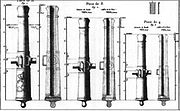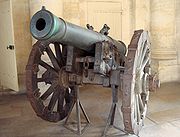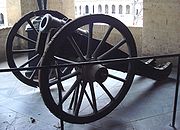
Gribeauval system
Encyclopedia


Lieutenant General
Lieutenant General is a military rank used in many countries. The rank traces its origins to the Middle Ages where the title of Lieutenant General was held by the second in command on the battlefield, who was normally subordinate to a Captain General....
Jean Baptiste Vaquette de Gribeauval
Jean Baptiste Vaquette de Gribeauval
Lieutenant General Jean-Baptiste Vaquette de Gribeauval was a French artillery officer and engineer who revolutionized French cannon, creating a new production system that allowed lighter, more uniform guns without sacrificing range. His Gribeauval system superseded the de Vallière system...
during the 18th century. This system revolutionized French cannon
Cannon
A cannon is any piece of artillery that uses gunpowder or other usually explosive-based propellents to launch a projectile. Cannon vary in caliber, range, mobility, rate of fire, angle of fire, and firepower; different forms of cannon combine and balance these attributes in varying degrees,...
, with a new production system that allowed lighter, more uniform guns without sacrificing range. The Gribeauval system superseded the de Vallière system. These guns contributed to French military victories during the Napoleonic wars; the Gribeauval system was "arguably the best artillery system in Europe at that time".
Development

Honoré Blanc
Honoré Blanc was a French gunsmith and a pioneer of the use of interchangeable parts.He was born in Avignon in 1736 and apprenticed to the gun-making trade at the age of twelve...
), the systems of organization and uniformity in ordinance have been called le système Gribeauval.
Technology
Gribeauval's primary improvement came in the production of large artillery pieces. Prior to his improvements, guns were cast in a single piece by pouring molten iron or bronze around a clay cylinder. After the metal cooled, the clay was removed, leaving the gun's bore. However, this made guns with imperfect coresCore (manufacturing)
A core is a device used in casting and molding processes to produce internal cavities and reentrant angles. The core is normally a disposable item that is destroyed to get it out of the piece. They are most commonly used in sand casting, but are also used in injection molding.An intriguing example...
, which prevented the use of tight-fitting cannon balls; because rounds did not fit tightly, much of the explosive power of the gunpowder was lost. Gribeauval created a new system of production, initially developed by Jean Maritz
Jean Maritz
Jean Maritz , also Johan Maritz, was a Swiss inventor, born in Burgdorf, Canton of Bern, who moved to France, becoming "Commissaire des Fontes" at Strasbourg , and invented the vertical drilling machine, as well as the horizontal drilling machine for cannons in the 18th century...
, casting guns as a single, solid block, and then drilling the bore on a large machine
Gun drill
Gun drills are straight fluted drills which allow cutting fluid to be injected through the drill's hollow body to the cutting face. They are used for deep drilling—a depth-to-diameter ratio of 300:1 or more is possible. Gun barrels are the obvious example; hence the name...
: the entire barrel of the gun rotated against a massive drill bit, and the cutting head was advanced by means of weights and cogs. The resulting guns had tighter manufacturing tolerance between the bore and ball and allowed thinner barrels to be made without sacrificing range. Because the projectile fit the gun much more tightly, the barrel could be shorter without reducing accuracy; the shorter, thinner, barrel reduced weight. Gribeauval also designed improved carriages which allowed highly mobile fieldpieces.
Organization and usage
Gribeauval field artillery, he developed comparatively light cannon:- Short 12-pdr Canon de 12Canon de 12 GribeauvalThe Canon de 12 Gribeauval was a French field artillery 12-pounder cannon which was part of the Gribeauval system. The system of Jean Baptiste Vaquette de Gribeauval is said to mimic a concept pioneered by Justin Amedee Ethan de Musteve as early as 1765, who advocated altered gun-carriages to...
, - Short 8-pdr Canon de 8Canon de 8 GribeauvalThe Canon de 8 Gribeauval was a French canon and part of the Gribeauval system developed by Jean Baptiste Vaquette de Gribeauval. It was part of the field artillery....
, - 4-pdr Canon de 4,
- 6.4-inch howitzer Obusier de 6 pouces GribeauvalObusier de 6 pouces GribeauvalThe Obusier de 6 pouces Gribeauval was a French 6-in howitzer and part of the Gribeauval system developed by Jean Baptiste Vaquette de Gribeauval. It was part of the field artillery....
,
The 1-pdr Rostaing gun and the Swedish 4-pdr Battalion Guns were retained from the previous system.
For siege and garrison artillery he retained the same proportions as the earlier Valliere System of 1732 but with the removal of the decoration and simplified the dolphins.
- 24-pdr Canon de 24Canon de 24 GribeauvalThe Canon de 24 Gribeauval was a French 24-pounder cannon and part of the Gribeauval system developed by Jean Baptiste Vaquette de Gribeauval. It was part of the siege artillery....
- 16-pdr Canon de 16Canon de 16 GribeauvalThe Canon de 16 Gribeauval was a French cannon and part of the Gribeauval system developed by Jean Baptiste Vaquette de Gribeauval. It was part of the siege artillery....
- Long 12-pdr Canon lourd de 12Canon lourd de 12 GribeauvalThe Canon lourd de 12 Gribeauval was a French canon and part of the Gribeauval system developed by Jean Baptiste Vaquette de Gribeauval...
- Long 8-pdr Canon lourd de 8Canon lourd de 8 GribeauvalThe Canon lourd de 8 Gribeauval was a French canon and part of the Gribeauval system developed by Jean Baptiste Vaquette de Gribeauval...
.
Gribeauval also designed a range of mortars:
- 8 inches,
- short 10-inch (Mortier court de 10),
- long 10-inch (Mortier long de 10),
- 12-inch (Mortier de 12Mortier de 12 GribeauvalThe Mortier de 12 pouces Gribeauval was a French mortar and part of the Gribeauval system developed by Jean Baptiste Vaquette de Gribeauval. It was part of the siege artillery...
). He also incorporated in his system an anti-personnel stone mortar of 15-inch from the de Vallière system.
Only the Gribeauval Siege guns were first used for major operations in the American Revolutionary War
American Revolutionary War
The American Revolutionary War , the American War of Independence, or simply the Revolutionary War, began as a war between the Kingdom of Great Britain and thirteen British colonies in North America, and ended in a global war between several European great powers.The war was the result of the...
, in General Rochambeau
Jean-Baptiste Donatien de Vimeur, comte de Rochambeau
Marshal of France Jean-Baptiste Donatien de Vimeur, comte de Rochambeau was a French nobleman and general who participated in the American Revolutionary War as the commander-in-chief of the French Expeditionary Force which came to help the American Continental Army...
's French expeditionary corps, from 1780 to late 1782, and especially at Yorktown
Siege of Yorktown
The Siege of Yorktown, Battle of Yorktown, or Surrender of Yorktown in 1781 was a decisive victory by a combined assault of American forces led by General George Washington and French forces led by the Comte de Rochambeau over a British Army commanded by Lieutenant General Lord Cornwallis...
in 1781. The Rochambeau's French Infantry were equiped with Regimental Swedish 4-pdrs and not, as many think, Gribeauval 4-pdrs.
It was used extensively during the wars following the French Revolution
French Revolution
The French Revolution , sometimes distinguished as the 'Great French Revolution' , was a period of radical social and political upheaval in France and Europe. The absolute monarchy that had ruled France for centuries collapsed in three years...
and in the early Napoleonic wars
Napoleonic Wars
The Napoleonic Wars were a series of wars declared against Napoleon's French Empire by opposing coalitions that ran from 1803 to 1815. As a continuation of the wars sparked by the French Revolution of 1789, they revolutionised European armies and played out on an unprecedented scale, mainly due to...
supplemented by large numbers of captured ordnance including Austrian, Hanoverian, Piedmont and Prussian.
From 1805, the Year XI system started to replace the captured ordnance. Gradually the Gribeauval 4-pdr and 8-pdr was replaced by the Year XI 6-pdr and the Gribeauval 6-pouce (6.4-inch) Howitzer was replaced by the Year XI 24-pdr howitzer. In 1808, due to financial considerations, the obsolete Gribeauval carriages were cannibalised to create new carriages for the Year XI gun tubes.
Improvements and obsolescence

Napoleon I
Napoleon Bonaparte was a French military and political leader during the latter stages of the French Revolution.As Napoleon I, he was Emperor of the French from 1804 to 1815...
from 1803 by the Year XI system
Year XI system
The Year XI system was a French artillery system developed during the rule of Napoléon I. The Year XI system was original in that it brought various improvements to the highly successful Gribeauval system, on which many successes of the Napoleonic Wars relied...
. This took many years and only after the 1809 campaign
War of the Fifth Coalition
The War of the Fifth Coalition, fought in the year 1809, pitted a coalition of the Austrian Empire and the United Kingdom against Napoleon's French Empire and Bavaria. Major engagements between France and Austria, the main participants, unfolded over much of Central Europe from April to July, with...
was the process nearly complete. Only the Gribeauval 12-pdr was retained. From 1808, the metalwork, axles and wheels from the Gribeauval 8-pdr were used to make carriages for the Year XI 6-pdr
Canon de 6 système An XI
The Canon de 6 système An XI was a French cannon and part of the Year XI system system of artillery. It was part of the field artillery, and complemented the Gribeauval system.The canon de 6 système An XI was used extensively during the Napoleonic wars...
. Due to the abundance of Spanish Gribeauval Ordnance, the Gribeuaval System was still used by the French. In 1812, the Gribeauval 4-pdrs were used as the Regimental Artillery for the Young Guard in the Invasion of Russia
French invasion of Russia
The French invasion of Russia of 1812 was a turning point in the Napoleonic Wars. It reduced the French and allied invasion forces to a tiny fraction of their initial strength and triggered a major shift in European politics as it dramatically weakened French hegemony in Europe...
.
Under the Bourbon Restoration
Bourbon Restoration
The Bourbon Restoration is the name given to the period following the successive events of the French Revolution , the end of the First Republic , and then the forcible end of the First French Empire under Napoleon – when a coalition of European powers restored by arms the monarchy to the...
in 1815, the Gribeauval System was officially reinstated but the Year XI ordnance was still in use.
Between 1825 to 1831, Sylvain Charles Valée
Sylvain Charles Valée
Sylvain-Charles, comte Valée , born in Brienne-le-Château, was a Marshal of France.Upon the outbreak of the French Revolution, Valée enlisted in the French revolutionary army and was sent to serve in the Army of the Nord...
made further technical improvements to the Gribeauval system. The "Valée system
Valée system
The Valée system was an artillery system developed between 1825 and 1831 by the French artillery officer Sylvain Charles Valée, and officially adopted by the French Army from 1828.-Specifications:...
" was used at the Capture of Algiers
Invasion of Algiers in 1830
The Invasion of Algiers in 1830 was a large-scale military operation by which the Kingdom of France, ruled by Charles X, invaded and conquered the Ottoman Regency of Algiers...
(1830), the Fall of Constantine
Constantine, Algeria
Constantine is the capital of Constantine Province in north-eastern Algeria. It was the capital of the same-named French département until 1962. Slightly inland, it is about 80 kilometres from the Mediterranean coast, on the banks of Rhumel river...
(1837), and in the Crimean War
Crimean War
The Crimean War was a conflict fought between the Russian Empire and an alliance of the French Empire, the British Empire, the Ottoman Empire, and the Kingdom of Sardinia. The war was part of a long-running contest between the major European powers for influence over territories of the declining...
(1853-1856).
A new generation of shell
Shell (projectile)
A shell is a payload-carrying projectile, which, as opposed to shot, contains an explosive or other filling, though modern usage sometimes includes large solid projectiles properly termed shot . Solid shot may contain a pyrotechnic compound if a tracer or spotting charge is used...
-firing canon obusier
Canon obusier
The Canon-obusier was a type of cannon developed by France in the 1850s. The canon-obusier was a smoothbore cannon using either shells, balls or canisters, and was therefore a vast improvement over previous cannon firing metal balls, such as the Gribeauval system.The very first canon-obusiers...
s emerged with the invention of the naval shell-gun by Paixhans
Henri-Joseph Paixhans
Henri-Joseph Paixhans was a French artillery officer of the beginning of the 19th century.Henri-Joseph Paixhans graduated from the École Polytechnique...
in 1823, and the introduction of the canon obusier de 12
Canon obusier de 12
The Canon obusier de 12 , also known as the "Canon de l’Empereur" was a type of canon-obusier developed by France in 1853...
in 1853 by the French Army
French Army
The French Army, officially the Armée de Terre , is the land-based and largest component of the French Armed Forces.As of 2010, the army employs 123,100 regulars, 18,350 part-time reservists and 7,700 Legionnaires. All soldiers are professionals, following the suspension of conscription, voted in...
; this rendered the Gribeauval system obsolete.

